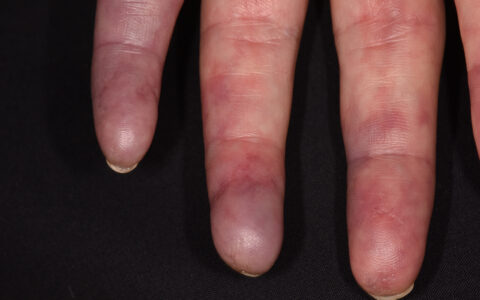Psoriatic arthritis often arises in people with psoriasis. Usually the skin symptoms come first, but sometimes the diseases present concurrently and, rarely, arthritis can come first.
Few studies have explored the potentially important relationship between the two diseases.
“Psoriasis can serve as a visible biomarker for a population at risk of developing psoriatic arthritis, and that presents us with an unusual opportunity to understand the natural history of psoriatic arthritis.”
For patients with possible rheumatoid arthritis, clinicians can test for certain antibodies to determine whether they also have psoriasis, but no such lab tests exist for psoriasis patients who have psoriatic arthritis.
“Psoriasis can serve as a visible biomarker for a population at risk of developing psoriatic arthritis, and that presents us with an unusual opportunity to understand the natural history of psoriatic arthritis,” said Paras Karmacharya, M.D., an instructor of medicine in the Department of Rheumatology at Vanderbilt University Medical Center and a co-author of a recent article in Seminars in Arthritis and Rheumatism.
“That understanding may ultimately help us devise strategies for preventing psoriatic arthritis in patients with psoriasis.”
Distinguishing Two Phenotypes
Karmacharya said her team wanted to identify characteristics associated with having a longer transition period between a psoriasis diagnosis and a psoriatic arthritis diagnosis, as well as the characteristics associated with a diagnosis of both conditions at almost the same time.
The study led to the identification of two distinct clinical phenotypes, one associated with the longer interval between psoriasis and psoriatic arthritis and the other a more concurrent diagnosis.
Patients who were younger when they developed psoriasis and those with more severe psoriasis were more likely to demonstrate a longer transition from psoriasis symptoms to psoriatic arthritis than patients who were older or who had milder cases.
“We found no significant differences between the two groups in terms of sex, race, smoking, BMI, alcohol use, or education,” Karmacharya said. “Neither were family histories significantly different.”
Genetics Won’t Suffice
Up to 30 percent of patients with psoriasis eventually develop psoriatic arthritis. Genetic factors, particularly human leukocyte antigen (HLA) subtypes, seem to have a role to play in determining the rate of progress, but studies suggest that genetics won’t provide the full explanation.
“The transition from psoriasis to psoriatic arthritis seems to begin with genetic factors, as well as environmental exposures, such as biomechanical stress or obesity,” Karmacharya said.
The investigators analyzed data from the Rochester Epidemiology Project, which includes more than five decades of comprehensive medical records for the residents of Olmsted County, Minnesota.
“This system ensures virtually complete ascertainment of all clinically recognized cases of psoriatic arthritis among the residents,” they wrote.
In a study population of 158 patients with incident psoriatic arthritis, 94 patients, or 59 percent, experienced onset of psoriasis before developing psoriatic arthritis, while 64 patients had concurrent development of psoriasis and psoriatic arthritis. The median time from psoriasis to psoriatic arthritis was 35.5 months, a number that rose to 118.5 months for those who had psoriasis before psoriatic arthritis.
Disease History Matters
This bipartite classification may have important implications for future epidemiological studies on the natural history of psoriatic disease and, ultimately, on the development of effective new treatments or preventatives.
“Characteristics related to delayed arthritis onset may provide future targets that can be used to develop treatments to slow down the transition to psoriatic arthritis. We think that the time to transition is very important.”
“Characteristics related to delayed arthritis onset may provide future targets that can be used to develop treatments to slow down the transition to psoriatic arthritis,” Karmacharya said. “We think that the time to transition is very important.”
Future Studies Needed
Genetic and immunological differences between those who made a fast transition and those who transitioned slowly were not considered as part of the study, which may be important issues for follow up, Karmacharya stated.
So far, the relationship between the two diseases has only been studied one of two ways.
“Some studies have considered genetics only. Some just considered clinical factors,” Karmacharya said. “We’re trying to understand which patients with psoriasis will transition to psoriatic arthritis, and then understand the interplay of both genetic and environmental factors. That will be a really good study.”




